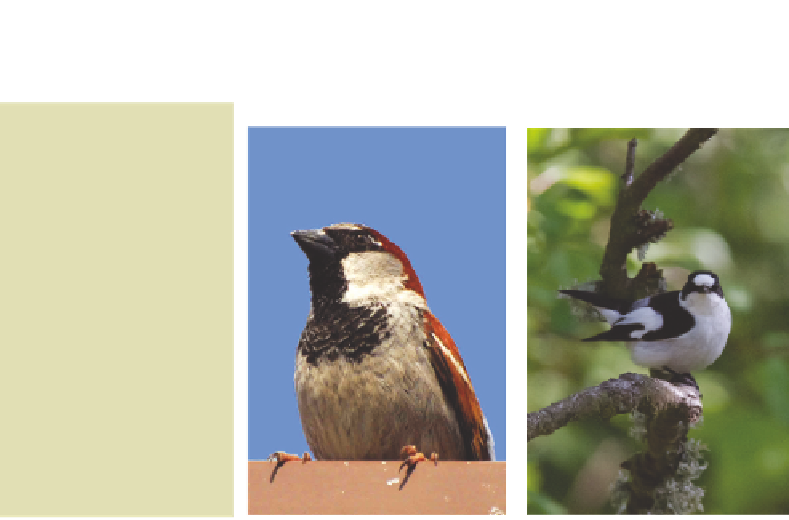Biology Reference
In-Depth Information
(a)
(b)
Fig. 14.11
Possible badges of
status. (a) The
black throat patch
or bib of male
house sparrows
(
Passer
domesticus
).
Photo © Tony
Barakat. (b) The
white forehead
patch of the
collared flycatcher,
Ficedula albicollis
.
Photo © Thor
Veen.
through increased aggression or punishment. Consequently, what would maintain
honesty is not the cost of producing the signal but rather the cost that would have to be
paid if a dishonest signal was produced.
Elizabeth Tibbetts and colleagues studied the facial patterns of female paper wasps,
Polistes dominulus
. This is a social species, where females often cooperate to found colonies.
Dominance determines the amount that each female reproduces, as well as settling
conflict in many other scenarios, such as the order of queen succession, sharing of food
and the probability of becoming a future queen. There is remarkable variation across
individuals in the number, size and shape of black spots on the otherwise yellow region
just above the mouth, the clypeus (Fig. 14.12). Tibbetts and Dale (2004) showed that this
variation was highly correlated to dominance - more dominant individuals had more
broken colouration, with more black spots. To an extent this was because larger individuals
had more spots, but the relationship held even when size was controlled for, with the
dominance rank between two wasps of the same size predicted by facial colouring.
Furthermore, wasps show clear behavioural differences in response to facing markings.
Tibbetts and Lindsay (2008) took pairs of same sized wasps with one black spot, and used
yellow paint to make one of the wasps have zero spots and the other two. They then killed
these wasps, placed each of them as a 'guard' of two sugar cubes in a corner of a triangular
arena, and introduced a third wasp to see where she would go. In 39 out of 48 cases, the
introduced wasp chose the food source with the guard who had less spots on her face.
These results beg the question of why don't wasps just exaggerate their size and
dominance by producing more spots? The production of spots is not likely to be costly,
because the black pigment required accounts for <1% of the total black pigment on a
wasp, and what matters anyway is how the black pigment is broken up into spots, not
the total amount. Tibbetts and Dale (2004) tested whether the apparent honesty of
facial markings could be explained by social costs that are imposed when individuals do
not signal honestly. They took pairs of similar sized wasps that had not previously
interacted, painted the face of one of them, to manipulate the number of spots, and then
placed them together. The wasps then battled for dominance, with the eventual winner
easily identified by 'mount' displays, where the loser lowers its antennae and allows
… could be
maintained by the
social cost of
dishonest signals
Black facial spots
are a signal of
status in hover
wasps





























